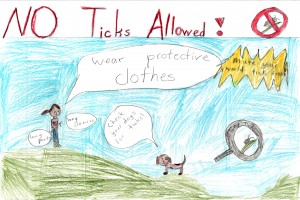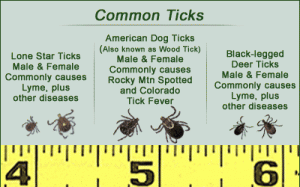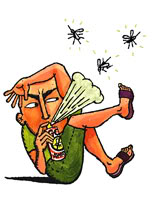 One of the great things about southern California – as far as being a horse is concerned – is the relative lack of insects and parasites that bother them, compared to other parts of the world. Most insects and parasites like moisture, and, unfortunately, SoCal, which normally has a pretty dry, desert-type client, is especially low on moisture now. But I digress.
One of the great things about southern California – as far as being a horse is concerned – is the relative lack of insects and parasites that bother them, compared to other parts of the world. Most insects and parasites like moisture, and, unfortunately, SoCal, which normally has a pretty dry, desert-type client, is especially low on moisture now. But I digress.
 In most of the world – and even sometimes in California – ticks can be an annoying problem for horses. Of course, they’re just disgusting little creatures (yes, one can go to veterinary school and still think that something is disgusting, by the way), and in addition to sucking blood, they also carry diseases, most especially Lyme disease and Anaplasmosis (you can learn more about the diseases by clicking on their names). They can also be irritating, if there are enough of them, they can such enough blood to cause anemia (especially in foals), and, in rare situations, a single tick can cause paralysis (CLICK HERE if you want to learn about tick paralysis in horses).
In most of the world – and even sometimes in California – ticks can be an annoying problem for horses. Of course, they’re just disgusting little creatures (yes, one can go to veterinary school and still think that something is disgusting, by the way), and in addition to sucking blood, they also carry diseases, most especially Lyme disease and Anaplasmosis (you can learn more about the diseases by clicking on their names). They can also be irritating, if there are enough of them, they can such enough blood to cause anemia (especially in foals), and, in rare situations, a single tick can cause paralysis (CLICK HERE if you want to learn about tick paralysis in horses).
 OH BY THE WAY – It’s called Lyme Disease (it’s NOT called Lymes Disease) because it’s named after a small coastal town in Connecticut called Lyme, where the disease was first discovered back in 1975.
OH BY THE WAY – It’s called Lyme Disease (it’s NOT called Lymes Disease) because it’s named after a small coastal town in Connecticut called Lyme, where the disease was first discovered back in 1975.
AND… The illustration for this part of the article is the 2014 winner of the annual “Tick Tock” poster contest in Maine. SoCal doesn’t have a “Tick Tock” poster contest (we have to find other ways to have fun, I guess), but all of us should send our most heartfelt congratulations to Grace VanBuskirk, a third grader at Owls Head Central School in Owls Head, Maine.
 But I’m not here to talk about Lyme Disease or Anaplasmosis (another day, I guess), I’m hear to talk about trying to keep ticks off of your horses, which is, of course, not the easiest of things to do, but, the better you can do it, the less likely it is that you’ll have to worry about tick-borne diseases. Heck, even if ticks didn’t cause disease, you’d still want to keep them off of you and you’re horse because they’re just gross. An ounce of prevention, as it were.
But I’m not here to talk about Lyme Disease or Anaplasmosis (another day, I guess), I’m hear to talk about trying to keep ticks off of your horses, which is, of course, not the easiest of things to do, but, the better you can do it, the less likely it is that you’ll have to worry about tick-borne diseases. Heck, even if ticks didn’t cause disease, you’d still want to keep them off of you and you’re horse because they’re just gross. An ounce of prevention, as it were.
LITERARY ASIDE: The axiom that “an ounce of prevention is worth a pound of cure” is was coined by none other than Benjamin Franklin. Franklin, however, wasn’t talking about health, he was talking about fire safety (under an assumed name). Whatever – it’s still a good quote. And if you really want to get into this quotation, CLICK HERE.
Anyway, let’s get down to business.
 First, some general information.
First, some general information.
- Ticks can be found just about anywhere. Your backyard. The woods. Your horse’s pasture (if he has a pasture). The trail. They are a part of life in most places.
- Ticks can be carried on, oh, just about anything that lives. Like birds. Or the entire class of mammals. All mammals.
- They can be carried on your clothes. Or on you – remember, you’re a mammal, too.
So now that we know that ticks are as ubiquitous as, oh, oxygen, what do you do?
1. Protect yourself
The best way to prevent tick problems is to keep them from getting on you in the first place. May be easier said than done, for sure, but you can sure:
- Wear protective clothing. Long sleeve shirts. Long pants. Gloves. Hats. Boots (cover up the laces, too, to keep ticks from crawling in).
- They make protective clothing that’s been pre-treated with insect repellents. Consider it.
- Check yourself all over for ticks after you’ve been in infested areas.
- Shower immediately after you’ve been outside, and scrub well to remove any of the little buggers.
2. Protect your horse
- Take a close look at your horse, before and after riding. Look especially at his lower legs and belly, and in crevices, such as between the legs or behind the elbow, around the sheath (in male horses, of course), and in the ears.
- Use a tick repellent.
“Tick repellant?” you say. “What kind of a tick repellent?” Here are some of the things that are used.
 Products with permethrin. There are about a million of them in the tack store. Permethrin is a common chemical that is essentially harmless to horses (it isn’t absorbed well through the skin), but especially nasty on ticks. Permethrin is such an important chemical agent that it’s on the World Health Orgaznization’s List of Essential Medicines (you can CLICK HERE to see all of them, since I knew you’d ask).
Products with permethrin. There are about a million of them in the tack store. Permethrin is a common chemical that is essentially harmless to horses (it isn’t absorbed well through the skin), but especially nasty on ticks. Permethrin is such an important chemical agent that it’s on the World Health Orgaznization’s List of Essential Medicines (you can CLICK HERE to see all of them, since I knew you’d ask).- Dog and cat repellents. The most popular of these contain a chemical called fipronil, which is toxic to the tick’s central nervous system. This is not approved for use in horses (it would probably cost too much money to test), but some people use it.
- Dilute malathion spray. Malathion is an insecticide in the chemical family known as organophosphates. You can buy it at just about any home and garden store. But pay attention – YOU CAN’T USE IT STRAIGHT OUT OF THE BOTTLE. You have to dilute it. Most recommendations are on the order of 1 part malathion to 32 parts water (that’s one ounce of malathion to a quart of water – 1/4 cup to a gallon for those of you who want to make it in bulk). I’ve doused horses being shipped to Hawaii with this solution – as is required by Hawaii state law – and it works great, even though it’s pretty stinky. Cheap, too.
IMPORTANT NOTE: CHECK WITH YOUR VETERINARIAN BEFORE YOU APPLY ANY CHEMICAL TICK REPELLENT TO YOUR HORSE.
Now I know what you’re thinking, especially if you’re of the “chemicals are bad” sort of frame of mind. You’re thinking, “I don’t want to use chemicals.”
You don’t have to. There are all sorts of “natural” products out there. Things like feeding your horse garlic, or spraying him with vinegar. But if you’re going down that route, be aware of one important fact: they don’t work.
How do you get ticks off your horse (or, ick, you)? Using a flat tweezers or needle-nosed pliers, grab the tick as close to the skin as you can gently pull it out. Don’t twist it out or jerk it out – just pull. Then go wash your hands. Wash the spot where you found the tick, and put a little disinfectant on it, if you’d like.
TICK REMOVAL MYTH – All of those old tricks to remove ticks – spraying them with alcohol, touching them with the hot head of a just-blown-out match, lacquering them with nail polish, a drop of perfume, petrolatum ointment – aren’t needed, and they can be dangerous (to you, not necessarily the tick).
 “But what about if part of the tick breaks off if you remove it?” you say.
“But what about if part of the tick breaks off if you remove it?” you say.
Don’t go digging. You can hurt yourself. Check with your doctor. It will be fine.
ANOTHER TICK MYTH – Even if you do leave a tick body part behind (say, the head), it won’t regrow a new tick. They are ticks, not a Cyberdyne Systems T-1000.
 3. Manage the land (as much as you can). Keeping your land as clean as you can helps remove spots where ticks can live. So:
3. Manage the land (as much as you can). Keeping your land as clean as you can helps remove spots where ticks can live. So:
- Remove debris – like leaves, brush, litter, or other trash, especially around the edges of pastures
- Create buffer zones to keep pastures and trails separate from wild areas. A ten foot space is a good idea.
- Don’t let horses graze in the woods.
- As cute as they can be, don’t attract tick-carrying wildlife to your horses with feed. Store grain in containers.
- Don’t feed the deer or the raccoon or the opossums, if you’re in an area that has such animals (not, for example, in Ireland).
- If you want more suggestions about land management, call a county extension agent, or a local university.
It’s worth the effort to try to keep ticks off of you and your horses if your horse is in infested area. It’s not all that difficult or expensive, either. Tick prevention can help prevent disease in your horse, and you’ll be less likely to get grossed out, too!









